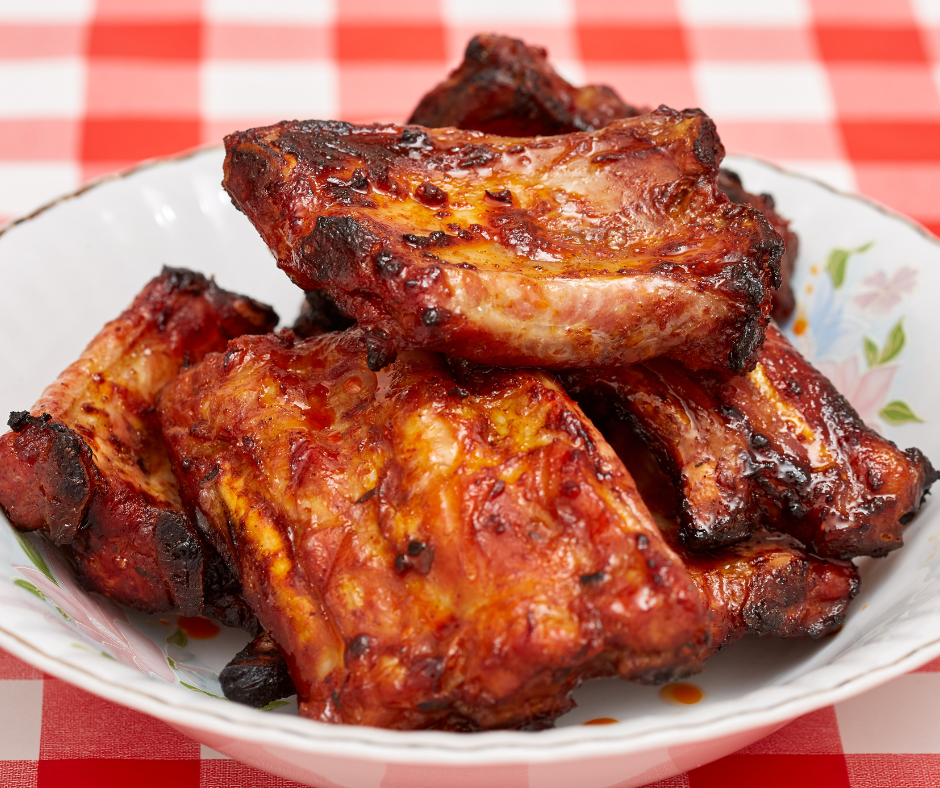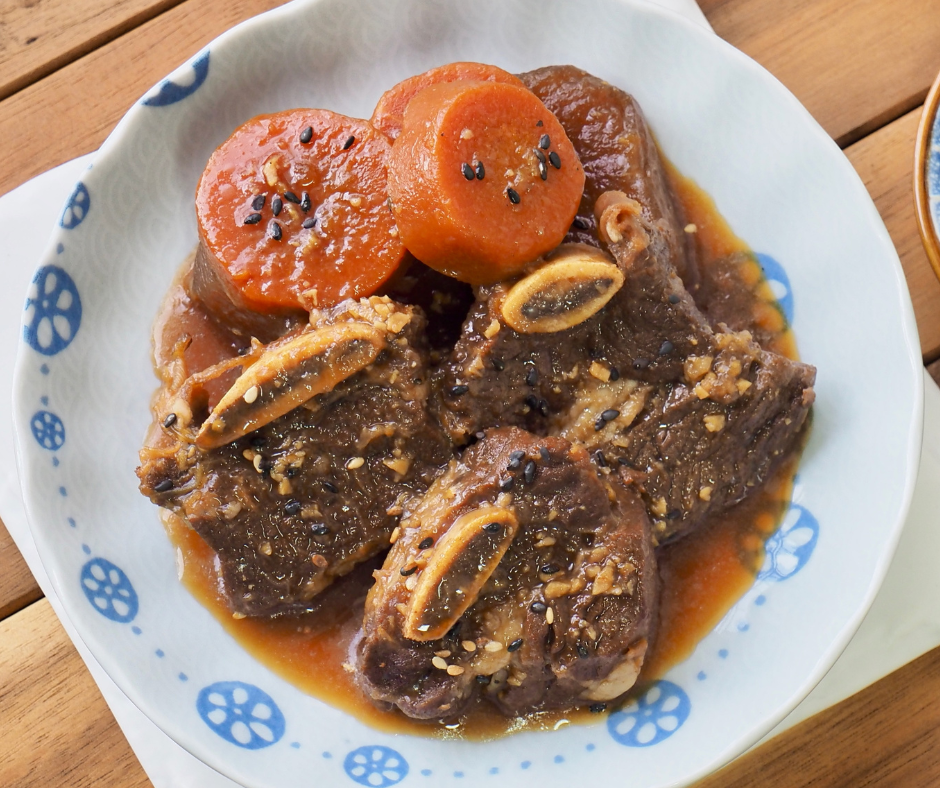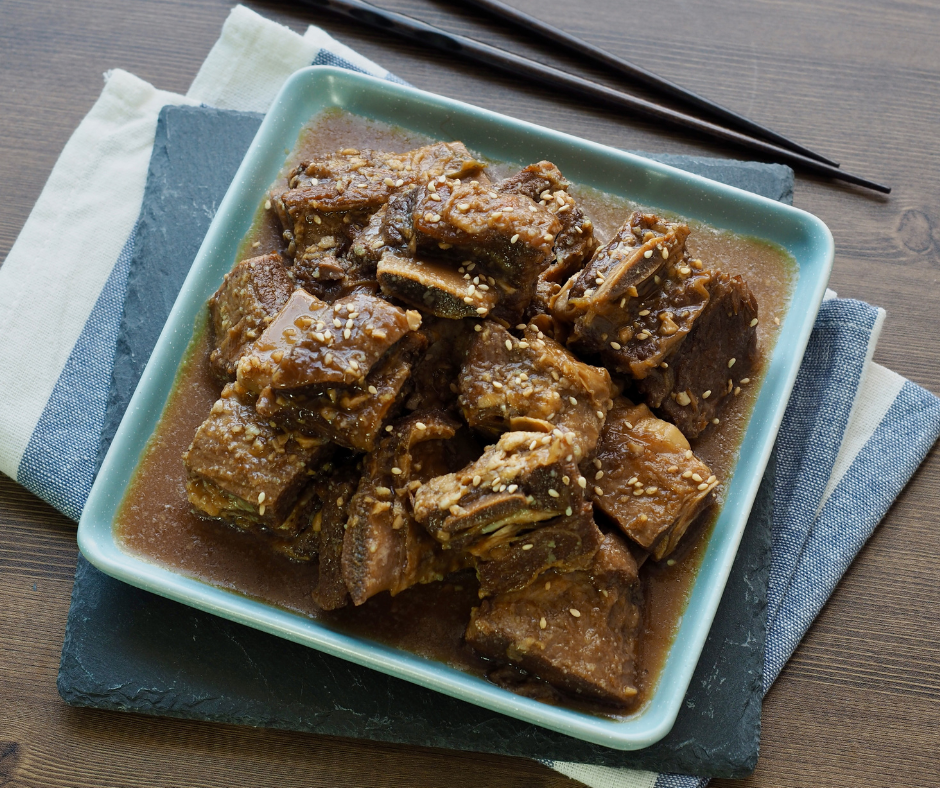Introduction
When choosing between short and spare ribs, meat lovers often find themselves in a problem. Both rib styles have unique qualities, making the decision tough. This article will comprehensively compare Short Ribs vs Spare Ribs, highlighting their defining characteristics and main differences.

Defining Short Ribs And Spare Ribs
Short ribs are meat cuts from the beef chuck or plate section. They are shorter and have a higher fat content, making them juicy and flavorful when cooked. Short ribs are perfect for slow cooking or braising, resulting in tender and melt-in-your-mouth deliciousness.
On the other hand, spare ribs are cut from the pork rib area. They have a curved bone structure and generally offer more bone than meat. Spare ribs are longer and have more layers of fat. They are well-suited for grilling or smoking over indirect heat, providing a stronger smoky flavor.
Main Difference Between Short Ribs And Spare Ribs
The main difference when you compare Short Ribs vs Spare Ribs lies in their anatomy. Short ribs have a more rectangular shape with more meat on each bone. They tend to be slightly sweeter due to their higher fat content, which adds to their flavor profile. On the other hand, spare ribs have a curved bone structure and generally offer more bone than meat. They have more layers of fat and provide a stronger smoky flavor from the bone marrow.
In conclusion, whether you choose short ribs or spare ribs, both styles have unique qualities. Short ribs are shorter and juicier, perfect for slow cooking or braising. Spare ribs are longer and offer a stronger smoky flavor, ideal for grilling or smoking. Consider your taste preferences, cooking method, and desired texture when deciding between these two delicious cuts of meat. Experiment with different recipes to find your favorite way of preparing and enjoying them.
Short Ribs
Anatomy And Flavors Of Short Ribs
As mentioned earlier, short ribs are cuts of meat from the beef chuck or plate section. They are shorter in length and have a higher fat content, which contributes to their juicy and flavorful nature. The rectangular shape of short ribs provides a generous amount of meat on each bone, making them perfect for slow cooking or braising. This cooking process allows the fat to render and the connective tissue to break down, resulting in tender and melt-in-your-mouth deliciousness.
In terms of flavor, short ribs have a slightly sweeter taste due to their higher fat content. The fat adds richness and depth to the meat’s flavor profile. When properly cooked, short ribs offer a juiciness and tenderness that is hard to resist.
Best Cooking Methods For Short Ribs
Braising is the most recommended cooking method for short ribs. This technique involves searing the short ribs and then simmering them in a flavorful liquid, such as broth or wine, at a low temperature. The slow cooking process allows the collagen in the meat to break down, resulting in tender and moist short ribs. Braising infuses the meat with complex flavors from the braising liquid, creating a delectable dish.
Another popular cooking method for short ribs is slow-roasting. This involves seasoning the ribs and cooking them in a low-temperature oven for an extended period. The slow-roasting process allows the fat to render gradually, resulting in tender and succulent meat.
Grilling or smoking short ribs can also yield delicious results, especially if you prefer a smokier flavor. However, it’s important to note that short ribs have a high fat content, which can lead to flare-ups on the grill. To prevent this, cooking them indirectly over medium heat and monitoring them closely is recommended.
In summary, short ribs are a flavorful and tender cut of meat that shines when slow-cooked or braised. Their higher fat content adds richness and depth to their flavor profile. Consider trying different cooking methods, such as braising or slow-roasting, to unleash the full potential of short ribs and enjoy their mouthwatering taste.
Stay tuned for the next section to explore the anatomy, flavors, and best cooking methods for spare ribs!

Spare Ribs
Anatomy And Flavors Of Spare Ribs
Spare ribs, like short ribs, are a popular and delicious cut of meat that can be enjoyed in various ways. They differ from short ribs in terms of their anatomy and flavor profile. Spare ribs come from the lower portion of the pig’s ribs, specifically from the belly and breastbone area. They have more bone and less meat compared to short ribs, but what they lack in meat, they make up for in flavor.
Spare ribs are known for their rich and smoky flavor. The meat on spare ribs is tender and juicy, with a good balance of fat that adds to their succulence. The connective tissues in spare ribs break down during cooking, resulting in a melt-in-your-mouth texture when properly seasoned and cooked; spare ribs offer a mouthwatering combination of savory and smoky flavors that are hard to resist.
Trimming And Cooking Spare Ribs
Before cooking spare ribs, some trimming is required to ensure a neat and consistent appearance. The most common trimming technique for spare ribs is the St. Louis cut. St. Louis cut ribs are spare ribs trimmed up a little more. This rib cut is preferred on the competition circuit, as it is neat for presentation. It involves removing the brisket bone and cartilage and trimming excess fat and meat to create a rectangular-shaped rack of ribs.
When it comes to cooking spare ribs, there are various methods you can choose from. One popular method is smoking, which infuses the ribs with a smoky flavor and creates a beautiful bark on the outside. Low and slow cooking is key to achieving tender and juicy spare ribs when using this method. Another option is grilling, which allows for a charred and caramelized exterior while keeping the meat moist and flavorful. Adding a flavorful rub or marinade before cooking can further enhance the taste of spare ribs.
In summary, spare ribs offer a rich, smoky flavor with a tender and juicy texture. They require some trimming before cooking; methods like smoking or grilling are recommended to bring out their best flavors. Whether you prefer the robust flavors of spare ribs or the succulent taste of short ribs, both cuts provide unique and delightful dining experiences. Explore different cooking methods and recipes to find your favorite way of preparing these mouthwatering rib cuts.
Choosing The Right Rib Cut
Factors To Consider When Choosing Between Short Ribs And Spare Ribs
When choosing between short ribs and spare ribs, several factors must be considered. These factors can help you make an informed decision based on your taste preferences, cooking method, and desired texture.
The first factor to consider is the cut of meat. Short ribs come from the cow’s rib section, while spare ribs are longer, with more bones and layers of fat. This difference in cut affects the texture and taste of the meat. Short ribs tend to be slightly sweeter due to their higher fat content, while spare ribs offer a stronger smoky flavor from the bone marrow.
Another important factor is your taste preferences. Short ribs may be the way to go if you prefer a richer, beefy taste with a slightly sweeter flavor. On the other hand, if you enjoy a strong, smoky flavor and don’t mind leaner meat with less fat, spare ribs might be more appealing.
Nutritional aspects also play a role in the decision-making process. While the nutritional content can vary depending on the cut and preparation method, short ribs and spare ribs are good protein sources. However, spare ribs may have a higher fat content due to the bone marrow.
Short Ribs vs Spare Ribs: Nutritional Aspects, Textures, And Flavors
Regarding the nutritional aspects of Short Ribs vs Spare Ribs, both provide a good amount of protein, which is essential for building and repairing muscles. However, if you are watching your fat intake, spare ribs may not be the best choice due to their higher fat content.
When it comes to textures, short ribs have a meaty and tender texture due to their higher fat content. The fat melts during cooking, making the meat incredibly succulent and flavorful. On the other hand, spare ribs have a leaner texture with less fat, but they can still be tender and juicy when cooked properly.
In the flavor department, short ribs offer a rich and beefy taste that is slightly sweeter. The higher fat content adds to the flavor and helps keep the meat moist during the cooking process. Spare ribs, on the other hand, have a strong, smoky flavor that comes from the bone marrow. Different cooking methods, such as smoking or grilling, can enhance this flavor.
In conclusion, choosing between short and spare ribs depends on personal preference. Consider factors such as the cut of meat, taste preferences, nutritional aspects, textures, and flavors. Experiment with different cooking methods and recipes to find your favorite way of preparing these mouthwatering rib cuts. Whichever you choose, short and spare ribs offer unique and delightful dining experiences.

Recipes And Dishes
Recommended Recipes For Short Ribs
Short ribs are a versatile cut of meat that can be prepared in various ways to bring out their rich and succulent flavors. Here are a few recommended recipes to try:
- Braised Short Ribs: This classic dish involves searing the short ribs to create a crust, then slow-cooking them in a flavorful broth until they become tender and fall off the bone. The result is a melt-in-your-mouth dish that is perfect for a cozy dinner.
- Korean-style Short Ribs (Galbi): Marinated in a mixture of soy sauce, garlic, sugar, and sesame oil, these short ribs are perfectly grilled. The marinade adds a sweet and savory flavor, while the grilling process gives the ribs a delicious charred exterior.
- Barbecue Short Ribs: These ribs are coated in a tangy, smoky barbecue sauce and then slow-cooked on the grill or in the oven. The low and slow cooking method allows the flavors to penetrate the meat, resulting in tender and flavorful ribs that are perfect for any barbecue gathering.
Recommended Recipes For Spare Ribs
Spare ribs are known for their smoky flavor and can be prepared in different ways to satisfy your taste buds. Here are a few recommended recipes to try:
- Smoked Spare Ribs: This recipe is a must-try if you own a smoker. The spare ribs are seasoned with a dry rub, then smoked slowly until tender and infused with a rich, smoky flavor. Serve them with your favorite barbecue sauce for a finger-licking experience.
- Oven-Baked Spare Ribs: For those who don’t have a smoker, you can still achieve delicious spare ribs by baking them in the oven. Start by seasoning the ribs with a dry rub, then slow-cook them at a low temperature until tender. You can finish them off with a brushing of barbecue sauce for that extra tangy flavor.
- Asian-style Spare Ribs: Marinated in a mixture of soy sauce, ginger, garlic, and honey, these spare ribs are then roasted in the oven until they are crispy and caramelized. The Asian-inspired marinade adds a sweet and savory flavor that pairs perfectly with the tender meat.
In summary, choose between short and spare ribs based on your taste preferences, cooking method, and desired texture. Enjoy experimenting with different recipes to find your favorite way of preparing these delicious cuts of meat. Whether you go for the rich and beefy taste of short ribs or the smoky flavor of spare ribs, both options will surely please your palate.
Conclusion
Now you should know how to compare Short Ribs vs Spare Ribs. Deciding between short and spare ribs ultimately comes down to personal preference. Both cuts have unique qualities and can be prepared in various delicious ways. Short ribs are shorter and have more fat content, resulting in juicy and flavorful meat. They are perfect for slow cooking or braising, which results in a tender and melt-in-your-mouth texture. On the other hand, spare ribs have longer bone and fat layers, making them well-suited for grilling or smoking over indirect heat. This method provides a stronger smoky flavor.
Key Takeaways From The Comparison
- Short ribs are shorter with more fat content, while spare ribs are longer with more bone and fat layers.
- Short ribs are perfect for slow cooking or braising, resulting in tender and flavorful meat.
- Spare ribs are great for grilling or smoking over indirect heat, which imparts a smoky flavor.
- Both cuts have their unique flavors and textures, making them incredibly delicious in their ways.
FAQ: Short Ribs vs Spare Ribs: A Comparison of Two Rib Cuts
Q: Are Flanken Beef Short Ribs and Beef Spare Ribs the same?
A: Flanken Beef Short Ribs and Beef Spare Ribs are the same meat. The difference between them lies in how they are cut.
Q: What are Short Ribs?
A: Short Ribs come from the lower half of the rib cage and are known for being meatier and tastier. They are typically cut across the bone to create 2-inch portions.
Q: How are Short Ribs cooked?
A: Short Ribs are often slow-cooked in a crockpot or pressure cooker. This cooking method makes the meat tender and allows it to fall off the bone easily.
Q: When comparing Short Ribs vs Spare Ribs, are they the same?
A: No, Spare Ribs and Short Ribs are different cuts. Spare Ribs are typically cut along the bone into 1-inch slices, while Short Ribs are cut across the bone into 2-inch portions.
Q: What is the difference between Beef and Pork ribs?
A: Beef ribs are fattier and more flavorful than pork ribs. However, pork spareribs cut from the sternum can be fattier and equally delicious.
Q: Which rib cut should I choose?
A: Short Ribs and Spare Ribs depend on personal preference and cooking method. Short Ribs are meatier and great for slow cooking, while Spare Ribs offer different textures and flavors depending on where they are cut.
Q: Are Korean Ribs the same as Short Ribs?
A: Yes, Korean Ribs are cut from the same part of the ribs as Short Ribs. The main difference is that Korean Ribs are usually cut 3/8 to a half-inch thick and are preferred for quick barbecuing.
Q: Where does the meat for Beef Back Ribs come from?
A: Beef Back Ribs are leftover from where the ribeye is cut away, meaning they are less meaty than other cuts.
Q: Can you recommend a recipe or cooking method for Short Ribs?
A: Slow-cooking Short Ribs in a crockpot or pressure cooker yields amazing results. The meat becomes tender and easily falls off the bone, making it a delight to savor.
Remember, beef and pork offer a variety of rib cuts, each with its unique taste and texture. It’s always best to experiment and find the cut that suits your palate and cooking preferences.
Graham Bartlett, owner at Taco and Piña Mexican food, is all about bringing the authentic flavors of Mexico to your plate. With Graham Bartlett, you can tantalize your taste buds with mouthwatering tacos and delicious piña coladas, all in one place. Stay connected and never miss a beat as Graham Bartlett takes you on a culinary journey through vibrant Mexican cuisine. Join the community and discover the perfect blend of flavor, culture, and passion that Graham Bartlett brings to the table. Experience the essence of Mexico, one bite at a time, with Graham Bartlett.
